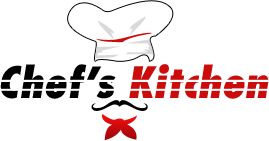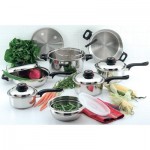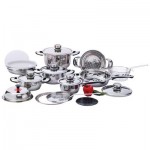Nutritional Cooking with Waterless Cookware
This quality set of waterless cookware is the result of the very best in research, quality and design for more than 50 years. Our waterless cookware is made of high grade surgical stainless steel with a special heat transmitting properties for fast and even heat distribution.
What’s so special about surgical stainless steel?
Our waterless cookware is made of a high grade 304 stainless steel. The element content of this special steel is important in the manufacture of a quality product.
There is almost no product that can’t be made more attractive, useful and durable with generous use of stainless steel. Beauty, corrosion resistance, strength and durability make a hard combination to beat.
But the main reason for its use is the high quality it gives to a product. Many superior properties of stainless steel give a new dimension to products for the home – permanence.
8 advantages of 304 surgical stainless steel
Corrosion Resistance
Superior ability to withstand all kinds of weather. Inside the home, it resists food acids, soaps, and detergents and most household products without pitting, staining or tarnishing.
Durability
One of the strongest, toughest, hardest metals used in consumer products. Resists chipping, denting, cracking, nicking and scratching even in severe service.
Cleanability
Soap and water do all but the toughest cleaning jobs. Stainless has no pores or cracks to harbor dirt and germs which accounts for its extensive use in hospitals, restaurants and dairies.
Flavor protection
A standard for cookware with professional chefs as well as in the home because it does not affect even the most delicate flavors.
Temperature Resistance
Can be used in all applications – from freezer to oven while retaining its excellent properties
Design Flexibility
Produced in a wide variety of commercial forms, textures and finishes. Can be readily formed and joined to meet the exacting demands of a wide variety of designs.
Economy
Priced low enough to be suitable for any consumer product. Its long-range economy and the customer satisfaction that results make its total cost even more attractive.
Beauty
Satin smooth or mirror bright, it is the most attractive metal available for consumer products. And its gleaming beauty blends with any décor.
| Cooking with steam control makes cooking as easy as 1, 2, 3: |
|
Why minimum moisture cookware cooks better:
Our waterless cookware uses multi-layers of heat-conducting metals with 12-element 304 surgical stainless exterior spreads the heat quickly and evenly.
Why is waterless cookware better for you?
Foods prepared the minimum moisture, low temperature way contain more vitamins and more minerals than foods prepared by other methods.
Only 2% *average mineral loss with our steam valve method…a savings up to 46.9%!
| Boiling | Pressure Cooking | |
| Iron | 48.9% | 17.3% |
| Calcium | 31.0% | 12.0% |
| Phosphorus | 46.4% | 19.4% |
| Magnesium | 44.7% | 21.1% |
This chart is based on the average percentage of mineral losses for all vegetables from “University of Wisconsin, Journal of Home Economics, Vol. 17, No. 5.”
- Ref.; Paul R. McCann, Food Specialist, author of the book The Science of Nutrition.
How to determine correct cooking temperatures:
|
GAS Range For MEDIUM-HIGH heat, the flame should just touch utensil bottom.
For MEDIUM heat, the flame should be about one-fourth inch high.
For LOW heat, the flame should be just barely visible |
USE MEDIUM-HIGH HEAT
USE MEDIUM HEAT
USE LOW (SIMMER) HEAT
|
ELECTRIC Range For MEDIUM-HIGH heat, switch to Medium-High position.
For MEDIUM heat, switch to Medium or Medium-Low position.
For LOW heat, switch to Low or Simmer position. |
Waterless cookware uses a low temperature method which can be used on any type stove. Because the degree of heat on different stoves will vary, it may be necessary for you to experiment. However, by following these general rules, along with a little practice at heat regulation… you’ll be delighted with the results. Remember waterless cooking is a low temperature method and requires lower heat than ordinary cooking methods.
If you become acquainted with the amount of heat each heating unit delivers, follow the timings in the General Directions.
If part of the heating unit is exposed around the utensil, it will not impair the coking efficiency. Where possible, use the pan that best fits the heating unit. Use smaller pans on the smaller units.
Never place a cold pan on a hot element. Always allow both units to heat simultaneously.
Basic Rules are Simple for using waterless cookware:
1. Always use the right pan
Select the pan the food will most nearly fill as air pockets created by “too large for the food quantity” pan will destroy vitamins, dry your foods and possibly burn.
2. Rinse prepared fruits and vegetables
Rinse produce in cold water and drain. Enough water clings to the food to combine with natural juices and cooks the food in its own steam. This is waterless, nutritional cooking. Until you get used to this new method, you should add 1/8” of water to the bottom of the pan.
3. Control the heat
throughout the cooking process. If you have too high a heat, it evaporates the steam and your food burns.
4. Get a vapor seal
Start the cooking process on medium heat until the lid begins to flutter. Then turn heat down to low or simmer. After you do this, the lid will form an airtight heat seal.
Watery type food (apples, cabbage) takes about 3 minutes. More solid food (potatoes, carrots) takes about 5 minutes for the lid to seal after turning the heat to low.
5. Don’t peek
Resist that urge to peek! When the cover is removed during the cooking period, heat and steam are allowed to escape. This lengthens the cooking time and dries out the food.
6. Be specific
Follow time charts, recipes and general instructions under specific headings of meats, Vegetables, etc. for the best in nutritional cooking.
General Directions for cooking Fresh Vegetables with waterless cookware:
Wash and remove blemishes. Do not peel unless recipe calls for it, by doing so you lose food value.
Place food in pan it will most nearly fill.
Freshen vegetables in water to bring back the natural moisture content and garden crispness (5-10 minutes), then drain.
Potatoes are usually cooked whole and must be thoroughly dried before cooking. If cut into halves or quarters to shorten cooking time, place skin side against the utensil. A slightly higher temperature is required for potatoes than other vegetables.
Cover and cook over medium heat for 3 to 5 minutes.
Reduce heat to Low and continue cooking for required length of time. Cooking time begins when heat is reduced to Low.
The time guide below is approximate. Actual cooking time will vary on the quantity, age and size being cooked.
| Cooking time in minutes on low heat | Cooking time in minutes on low heat | ||
| Asparagus | 18-20 | Okra | 15-20 |
| Beans, green or wax (cut) | 25-30 | Onions (whole) | 20-30 |
| Beans, Lima | 35-39 | Parsnips (sliced) | 15-25 |
| Beets, whole | 35-40 | Peas | 15-20 |
| Broccoli | 15-20 | Potatoes, white (quartered) | 20-25 |
| Brussels Sprouts | 15-20 | Potatoes, sweet (baked on stove) | 35-45 |
| Cabbage (shredded) | 10-15 | Potatoes, (baked) medium | 50-55 |
| Carrots (sliced) | 15-20 | Spinach | 8-12 |
| Cauliflower (flowerets) | 10-15 | Squash, summer (cubed) | 15-20 |
| Celery (1 inch length) | 10-15 | Squash, winter | 30-40 |
| Corn | 10-12 | Tomatoes | 10-15 |
| Greens | 10-12 | Turnips (peel and slice) | 25-30 |
General Directions for cooking Frozen Vegetables using waterless cookware:
Use a pan that food will most nearly fill.
Food need not be thawed.
Use no water. Due to dryness, lima beans and frozen corn require crisping in cold water 5 minutes before cooking.
Cover pan. Start on medium heat 5-10 minutes, or until vapor appears, then reduce to Low.
Shake pan holding cover tight once during starting time, and once during second period.
Continue cooking until done. Season at end of cooking.
Cooking time begins when heat is reduced to Low.
The time guide below is approximate. Actual cooking time will vary depending on the quantity and size being cooked.
| Minutes | |
| Asparagus | 10-12 |
| Beans, Green | 15-20 |
| Broccoli | 10-12 |
| Brussels Sprouts | 7-10 |
| Cauliflower | 8-10 |
| Carrots and Peas | 5-7 |
| Corn (cut) (see general directions) | 12-15 |
| Lima Beans (see general directions) | 5-20 |
| Peas | 5-7 |
| Spinach | 5-7 |
| Squash | 10-12 |
If vegetables have thawed the cooking time begins at the time the pan is put over heat.




